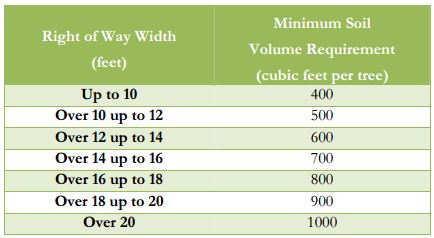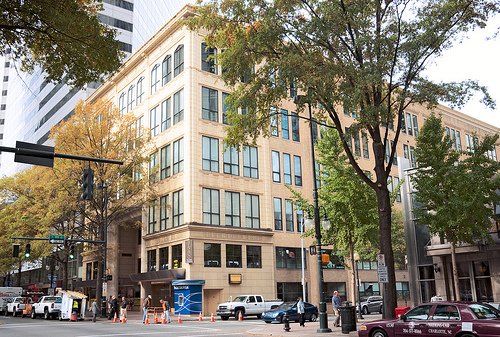This post is now out of date! Please see the updated post here.
In the day-to-day, we can become so focused on what isn’t working with the way we design and plant street trees that it can be difficult to focus on the people and places that are actually doing right by them. It’s just so much easier than trying to move the needle.
To that end, I want to recognize the envelope-pushers — those municipalities that are rethinking the vital role trees play in the health of our planet and population and creating rules and recommendations to support them. They take action every day by promoting policies and projects that set trees up for long-term success and environmentally meaningful contribution.
We’ve identified the following communities for their ambitious policies that are redefining requirements for green utilities, specifically for trees, soil and stormwater management:
- Raleigh, NC’s Street Design Manual – As of July 2013, Raleigh, NC requires a minimum of 600 cubic feet of soil for all street trees planted in the right of way for new developments. Their new Street Design Manual outlines this requirement, and the design methods available for achieving it, in section 6.18, page 82-86. The design standards also specify that soil volumes should be connected wherever possible to increase the overall amount that is available to the roots.
- Toronto’s Green Development Standard – Perhaps the most ambitious initiative we’ve yet seen, the City of Toronto calls for street trees to get a minimum of 15 m3 (529 ft 3)of high quality soil per tree if in a shared planter, and a minimum volume of 30 m3 (1,059 ft3) of soil per tree if in a single planter.
- Tigard, OR Urban Forestry Manual – In March 2013, the City of Tigard, OR (just outside of Portland), enacted a soil volume minimum for street and parking lot trees that requires from 400 to 1,000 cubic feet of soil depending on the width of the right of way:
The new regulations include minimum soil volume requirements for parking lot trees and street trees. The soil volume standards for street trees are outlined in Section 12 of the Urban Forestry Manual and are based on the width of the non-street portion of the right of way.  The soil volume standard for parking lots trees is 1000 cubic feet of soil volume per tree. Appendices 11 through 15 of the Urban Forestry Manual include example soil volume plans specifications and calculations. In addition, parking lots are required to be designed to achieve 30% tree canopy cover at tree maturity. Section 13 of the Urban Forestry Manual includes the Parking Lot Tree Canopy design requirements. Appendices 16 through 18 include example parking lot tree canopy plans, specifications and calculations.
The soil volume standard for parking lots trees is 1000 cubic feet of soil volume per tree. Appendices 11 through 15 of the Urban Forestry Manual include example soil volume plans specifications and calculations. In addition, parking lots are required to be designed to achieve 30% tree canopy cover at tree maturity. Section 13 of the Urban Forestry Manual includes the Parking Lot Tree Canopy design requirements. Appendices 16 through 18 include example parking lot tree canopy plans, specifications and calculations.
- Durham, NC Landscape Manual – this new manual requires the following minimum soil volumes for street trees:
Large trees = 700 cubic feet
Medium trees = 500 cubic feet
Small trees = 300 cubic feet
- Oakville, ON – this City requirement calls for 30m3 (1,059 ft3) of soil per tree, or 15 m3 (530 ft3) if in a shared trench.
- Baltimore Waterfront Healthy Harbor Initiative – This initiative sets an example for increasing the tree canopy as a way to preserve the environment and manage stormwater. Using permeable paving, landscaping, rain gardens, and green roofs, it asks for sites to filter more than 50 percent of stormwater runoff from areas and install at least 1,500 cubic feet of soil for tree pits using structural soils or suspended pavement for any new impervious surfaces or retrofit/redevelopment projects.
- University of Florida (IFAS Extension) – The project created an Urban Design for a Wind Resistant Urban Forest. Planners increased the soil and depth requirements to allow trees to mature and live longer using the following guidelines (soil area based on mature tree size, 3’ deep or greater):
Small (shorter than 30’) = 10’x10’x3’ = 300 ft3
Medium (Less than 50’ height or spread) = 20’x20’x3’ = 1,200 ft3
Large (Greater than 50’ height or spread) = 30’x30’x3’ = 2,700 ft3
- West Virginia Department of Environmental Protection – The community created a municipal handbook to manage wet weather through specific green infrastructure and made the following soil recommendations based on those from Prince William County, VA:
Large tree = 970 ft3
Medium tree = 750 ft3
Small tree = 500 ft3
- Athens-Clarke County, Georgia – The community created best management practices for community tree planting and soil volume minimums:
Small Canopy: 100 square feet x 2’ deep = 200 ft3
Medium Canopy: 225 square feet x 2’ deep = 450 ft3
Large Canopy: 400 square feet x 2’ deep = 800 ft3
- State of Minnesota Sustainable Building Guidelines (MSBG) – Where trees are planted in hard surfaces, the community uses a structural soil media mix of minimum soil volume of 500 cubic feet (cf) per tree. If soil volumes cannot be met it is recommended that trees be planted in minimum 8′ wide by approximately 3′ deep trenches so that soil volumes are shared between trees.
- Charlotte, North Carolina & Mecklenburg County – Planners amended the planting area requirements and recommendations for commercial development to increase the absolute minimum soil volume and planting area to 274 square feet per tree. The minimum width of the planting area is 8’ at the trunk of the tree.
- British Columbia (Canada) 7th Edition BC Landscape Standard – Recommended minimum soil volume per tree of 6m3 (212ft3), and more is better.
- Markham, Ontario “Trees for Tomorrow: Streetscape Manual” – These design guidelines make the following soil volume recommendations:
Large stature tree in boulevard = 30 cubic meters/1,059 cubic feet (if single) or 15 cubic meters/530 cubic feet (if shared) of root space
Medium stature tree in boulevard = 23 cubic meters/812 cubic feet of root space
Small stature tree = 15 cubic meters/530 cubic feet root space
Minimum soil volume for tree planting in a parking lot island is 15 cubic meters/530 cubic feet.
- Aspen, Colorado & Pitkin County – The community amended its structural soils specifications so that soil area is now based on a targeted mature tree size, requiring 30 inches or more depth and a correcsponding increase in soil volume.
Soil area based on mature tree size, 30” deep or greater
Small (shorter than 30’) = 10’x10’x2.5’ = 250 ft3
Medium (Less than 50’ height or spread) = 20’x20’x2.5’ = 1,000 ft3
Large (Greater than 50’ height or spread) = 30’x30’x2.5’ = 2,250 ft3
- Chicago Landscape Ordinance – The city amended planting standards and now requires parkway trees to have a minimum depth of three feet of soil. Planting areas require a minimum of 24 square feet of surface area with no dimension less than three feet.
- Denver Parks and Recreation Forestry Department – The city’s “Street Tree Plan Review Checklist” sets a soil volume minimum of 750 cubic feet of soil per tree and states that, “5’ x 5’ pit areas shall no longer be accepted, must use trenches, root paths, break out zones, structural cells, or other un-compacted soil technology.”
- Emeryville, California – The community requires minimum rootable soil volumes for new trees planted in the public right of way by private developers. The minimum is based on the size of the tree at maturity: 600 cubic feet for a small tree, 900 for a medium tree and 1200 for a large tree.
- Alexandria, Virginia – The city’s Landscape Guidelines specify that street trees be provided with a minimum of 300 cubic feet of soil per tree and recommends that one tree be present for every ten spaces in parking areas.
Are any of these perfect? Probably not. Certainly there are things we would change about almost all of them. Still, setting soil volume minimums for street trees tacitly enforces the message that business as usual as far as tree planting is concerned isn’t good enough.
We need to rethink how we plan for our urban forests and the role of green infrastructure in the built environment. The new game in town is high performance urban forestry.
Are you involved with making soil volume recommendations for trees? Hopefully you can use some of this information to help persuade your co-workers and clients of this important effort.
Should your city or town be on this list, or do you know of any others that we missed? We want to hear about your goals for growing healthy trees in your community. Please email us at [email protected].






Nice post. All information are Impressive. Thank you for this information.